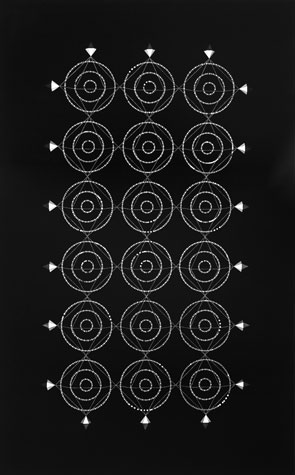
LOOM OF MASTERY ‘Serape,’ by Grace DeGennaro. |
If you’re going to explore the cosmos, better do it at night. In each piece shown in Grace DeGennaro’s Indigo Series, indigo pigment is layered beneath a heavy black palette, recreating the active, damp hues of a rural night sky. In this setting, DeGennaro’s celestial explorations come into focus. Using rich colors, repetitive patterns, and a limited vocabulary of shapes, these pieces seem like snapshots of carnivals light years away.
One of the most interesting features of the Indigo Series is the way it both showcases and restrains DeGennaro’s formal style. One of her signature techniques is replicating the delicate, arbitrary precision of mosaics with intricately patterned oil-based paint. Nearly all of the works in Indigo feature this method (one piece is watercolor on Arches paper), but against the black backdrop, the mosaic technique creates neither a picture nor a scene. Compared to DeGennaro’s earlier work, this show marks a starker, less representational update to last year’s “Return to the Source” exhibit at the Clark Gallery in Lincoln.
Another is the symbolic depth of the vocabulary. The Indigo Series relies heavily on floating figures of circles, diamonds, and, most notably, the vesica piscis (the vaguely football-ish shape formed by two overlapping circles), one of the cornerstone symbols of Sacred Geometry. Depending on whom you ask, the shape of the vesica piscis is the symbolic, mathematical structure embedded in any number of religious and spiritual doctrines, from Judeo-Christian creationism to quasi-Buddhist meditations on Unity to the serpentine, naturalist art found in Amazonian shamanism. It’s a pretty heavy hitter. That it appears so prominently in these paintings without pledging artistic faith to any of those movements is a credit to DeGennaro’s originality and the effectiveness of the rules of “Indigo.”
In an exhibit with so much structural uniformity, many of the standouts are pieces that constitute a break with DeGennaro’s code. In “Blueprint,” dual bulbs of vibrant fern-green vesica piscis petals are held together by three circles formed from mosaic-like black and white beads. Of all the 34-by-21-inch pieces in the series, “Blueprint” is the most intriguing, benefiting from the vaguely hallucinogenic green and simple, serial beads. While the pattern of “Blueprint” is echoed in “Mantilla,” a sister piece, the use of color in the former is unlike any other in the series.
“Creation,” the only nonsymmetrical piece in the series, is also the most reminiscent of Byzantine mosaics. Two polygon figures, brightly rendered in beads, are stacked upon the familiar three-ringed circle. With the exception of the diamond (treated by DeGennaro as a geometric derivative of the vesica piscis), the square and isosceles triangle in “Creation” are the only such figures in all of the series, and like the bold color in “Blueprint,” their deployment seems to deviate the code.
Perhaps the masterwork of the series, “Serape” is an enormous eight-by-five-foot loom articulating DeGennaro’s celestial vision. Anchored at each end by yin-yang diamond cuffs, a floating, imposing grid of beaded circles is shadowed by a constellation of thin gray and white diamonds. Like cells in a DNA double helix, no pattern of color in any of the circles is alike, each is predominantly red and blue with noisy incongruities from the entire color spectrum near the core. It is latent but persistent irregularities like these that make up much of the appeal of the Indigo series.
Nicholas Schroeder can be reached at mrnicholasschroeder@gmail.com.
“INDIGO” | Works by Grace DeGennaro | at Aucocisco Gallery, 89 Exchange St, Portland | April 2-24 | Reception April 2 5-8 pm | 207.775.2222